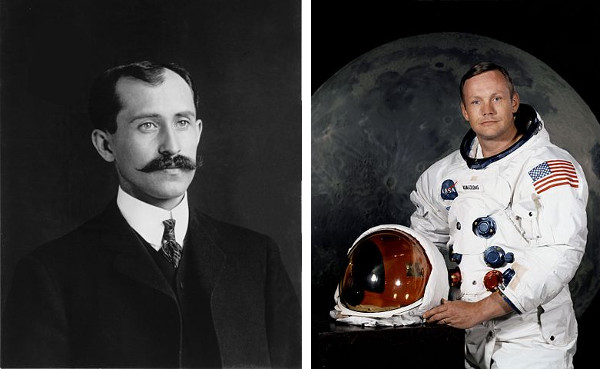
When Orville Wright died, Neil Armstrong was already 17 years old.

When Orville Wright died, Neil Armstrong was already 17 years old.
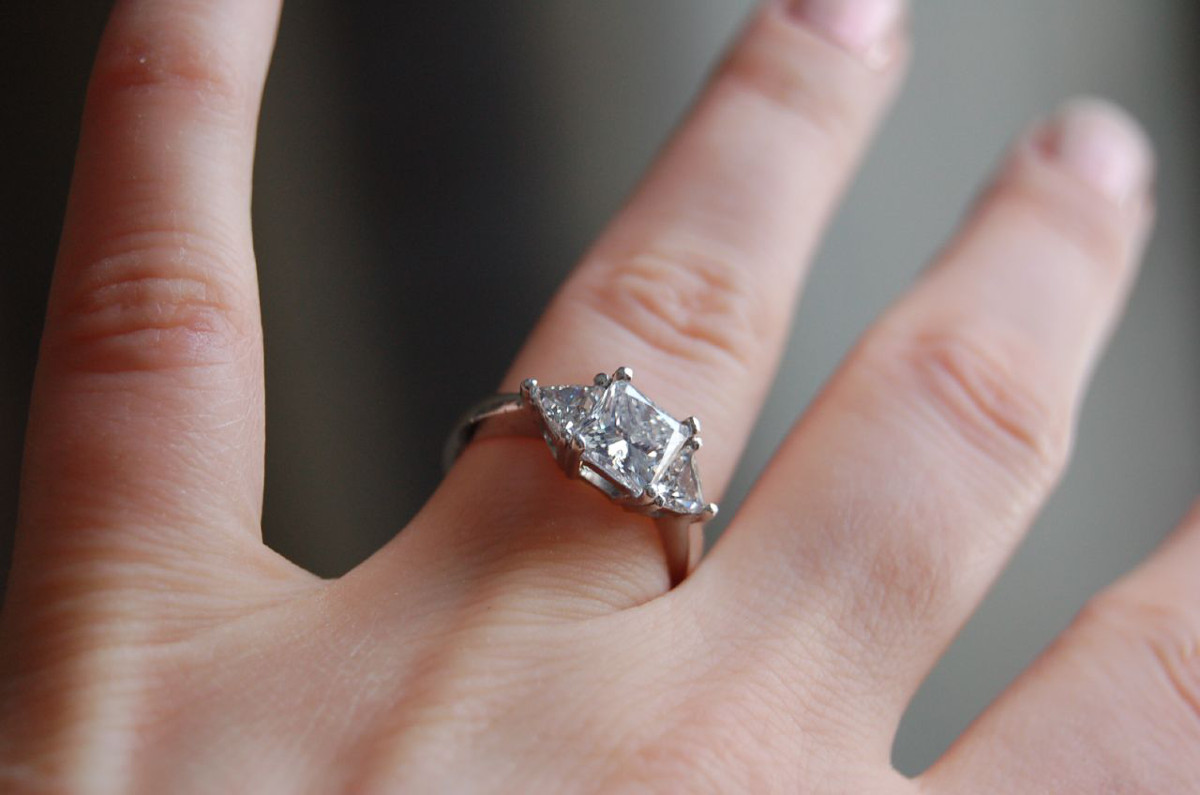
Why do we give gifts during courtship, and what makes a good gift? In 2005, University College London mathematicians Peter D. Sozou and Robert M. Seymour modeled the question with a game. The male begins by offering one of three gifts — valuable, extravagant, or cheap — depending on how attractive he finds the female. After he offers the gift, she decides whether to accept it and mate with him. Afterward, he decides whether to stay with her or seek another partner.
Each is trying to judge the intentions of the other. She must decide whether he wants a serious relationship or only a brief encounter, and he must decide whether she’s really attracted to him or only wants the gift.
According to the courtship game, the most successful strategy for the male is to offer an “extravagant” gift that’s costly to him but intrinsically worthless to the female. This tells the female that he has resources and values her highly, but it protects him from coy fortune-hunters.
“By being costly to the male, the gift acts as a credible signal of his intentions or quality,” write Sozou and Seymour. “At the same time, its lack of intrinsic value to the female serves to deter a ‘gold-digger’, who has no intention of mating with the male, from accepting the gift. In this way, an economically inefficient gift enables mutually suitable partners to be matched.”
(Peter D. Sozou and Robert M. Seymour, “Costly But Worthless Gifts Facilitate Courtship,” Proceedings of the Royal Society B 272, 1877–1884, July 26, 2005.)

A replacement for the Turing test has been proposed. The original test, in which a computer program tries to fool a human judge into thinking it’s human during a five-minute text-only conversation, has been criticized because the central task of devising a false identity is not part of intelligence, and because some conversations may require relatively little intelligent reasoning.
The new test would be based on so-called Winograd schemas, devised by Stanford computer scientist Terry Winograd in 1972. Here’s the classic example:
The city councilmen refused the demonstrators a permit because they [feared/advocated] violence.
If the word feared is used, to whom does they refer, the councilmen or the demonstrators? What if we change feared to advocated? You know the answers to these questions because you have a practical understanding of anxious councilmen. Computers find the task more difficult because it requires not only natural language processing and commonsense reasoning but a working knowledge of the real world.
“Our WS [Winograd schemas] challenge does not allow a subject to hide behind a smokescreen of verbal tricks, playfulness, or canned responses,” wrote University of Toronto computer scientist Hector Levesque in proposing the contest in 2014. “Assuming a subject is willing to take a WS test at all, much will be learned quite unambiguously about the subject in a few minutes.”
In July 2014 Nuance Communications announced that it will sponsor an annual Winograd Schema Challenge, with a prize of $25,000 for the computer that best matches human performance. The first competition will be held at the 2016 International Joint Conference on Artificial Intelligence, July 9-15 in New York City.
Here’s another possibility: Two Dartmouth professors have proposed a Turing Test in Creative Arts, in which “we ask if machines are capable of generating sonnets, short stories, or dance music that is indistinguishable from human-generated works, though perhaps not yet so advanced as Shakespeare, O. Henry or Daft Punk.” The results of that competition will be announced May 18 at Dartmouth’s Digital Arts Exposition.
(Thanks, Kristján and Sharon.)
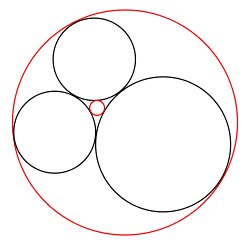
In 2014 I described Descartes’ theorem, which shows how to find a fourth circle that’s tangent to three “kissing circles.”
Descartes’ equation refers to the “curvature” of each circle: this is just the reciprocal of the radius, so a circle with radius 1/3 would have a curvature of 3. (This makes sense intuitively — a circle with a small radius “curves more” than a larger one.)
Remarkably, if the four starting circles all have integer curvature, then so will every circle we pack into the figure, each kissing the three around it. In the limit the figure becomes a fractal containing an infinite number of circles. It’s called an Apollonian gasket.
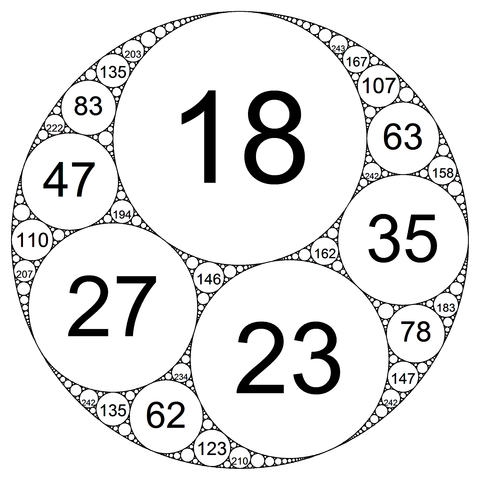
07/29/2016 UPDATE: By coincidence, the U.S. quarter, nickel, and dime make three of the four generating circles in an integral packing — see the caption accompanying the first figure on this page. (Thanks, Trevor.)
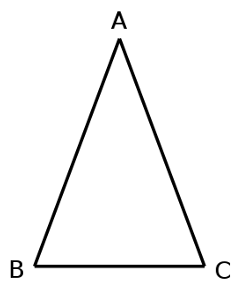
Here’s an isosceles triangle. Sides AB and AC are equal, and this means that the angles opposite those sides are equal as well.
That’s intuitively reasonable, but proving it is tricky. Teachers of Euclid’s Elements came to call it the pons asinorum, or bridge of donkeys, because it was the first challenge that separated quick students from slow.
The simplest proof, attributed to Pappus of Alexandria, requires no additional construction at all. We know that two triangles are congruent if two sides and the included angle of one triangle are congruent to their corresponding parts in the other (the “side-angle-side” postulate). So Pappus suggested simply picking up the triangle above, flipping it over, and putting it down again, to produce a second triangle ACB. Now if we compare the respective parts of the two triangles, we find that angle A is equal to itself, AB = AC, and AC = AB. Thus the “left-hand” angles of the two triangles are congruent, and it follows that the base angles of the original triangle above are equal.
In his 1879 book Euclid and his Modern Rivals, Lewis Carroll accepts the proof but remarks that it “reminds one a little too vividly of the man who walked down his own throat.”

In 1952, French physician Alain Bombard set out to cross the Atlantic on an inflatable raft to prove his theory that a shipwreck victim can stay alive on a diet of seawater, fish, and plankton. In this week’s episode of the Futility Closet podcast we’ll set out with Bombard on his perilous attempt to test his theory.
We’ll also admire some wobbly pedestrians and puzzle over a luckless burglar.

What’s the most effective strategy for loading an airplane? Most airlines tend to work from the back to the front, accepting first the passengers who will sit in high-numbered rows (say, rows 25-30), waiting for them to find their seats, and then accepting the next five rows, and so on. Both the airline and the passengers would be glad to know that this is the most effective strategy. Is it?
In 2005, computer scientist Eitan Bachmat of Ben-Gurion University decided to find out. He devised a model that considers parameters of the aircraft cabin, the boarding method, the passengers, and their behavior, and found that the most important variable is a combination of three parameters: the length of the aisle blocked by a standing passenger, multiplied by the number of seats in a row, divided by the distance between rows. If rows are 80 centimeters apart, there are six seats in a row, and a standing passenger and his hand luggage take up 40 centimeters of the aisle, then the passengers headed for a single row will block the aisle space of three rows while they’re waiting to reach their seats.
This quickly backs things up. Even if the airline admits only passengers with row numbers 25-30, half the aisle will be completely blocked and most passengers will have to wait until everyone in front of them has sat down before they reach their seats. The time it takes to fill the cabin grows in proportion to the number of passengers.
A better policy would be to call up the passengers in rows 30, 27, and 24; then those in 29, 26, and 23; and so on (perhaps using color-coded boarding passes). These combinations of passengers would not block one another in the aisles.
An even better policy, Bachmat found, would be to dispense with seat assignments altogether and let passengers board the plane and pick their seats as they please. “With this method, or lack of a method,” writes George Szpiro, “the time required to get people on board and into their seats would only be proportional to the square root of the number of passengers.”
(Eitan Bachmat et al., “Analysis of Airplane Boarding Times,” Operations Research 57:2 [2009]: 499-513 and George S. Szpiro, A Mathematical Medley, 2010. See All Aboard.)

In 1897, confused physician Edward J. Goodwin submitted a bill to the Indiana General Assembly declaring that he’d squared the circle — a mathematical feat that was known to be impossible. In today’s show we’ll examine the Indiana pi bill, its colorful and eccentric sponsor, and its celebrated course through a bewildered legislature and into mathematical history.
We’ll also marvel at the confusion wrought by turkeys and puzzle over a perplexing baseball game.
Today marks the 400th anniversary of William Shakespeare’s death. To commemorate it, Craig Knecht has devised a 44 × 44 magic square (click to enlarge). Like the squares we featured in 2013, this one is topographical — if the number in each cell is taken to represent its altitude, and if water runs “downhill,” then a fall of rain will produce the pools shown in blue, recalling the words of Griffith in Henry VIII:
Noble madam,
Men’s evil manners live in brass; their virtues
We write in water.
The square includes cells (in light blue) that reflect the number of Shakespeare’s plays (38) and sonnets (154) and the year of his death (1616).
(Thanks, Craig.)
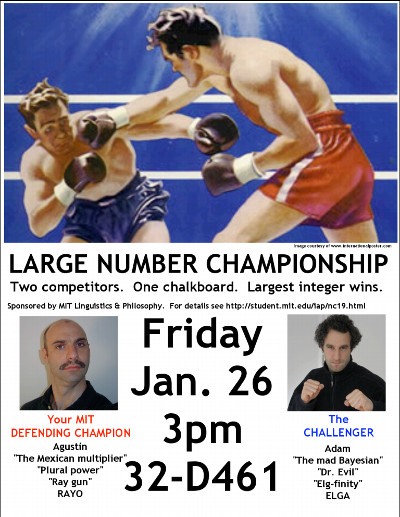
In January 2007, inspired by this article by computer scientist Scott Aaronson, philosophers Agustín Rayo of MIT and Adam Elga of Princeton joined in the “large number duel” to come up with the largest finite number ever written on an ordinary-sized chalkboard.
The rules were simple. The two would take turns writing down expressions denoting natural numbers, and whoever could name the largest number would win the duel. No primitive semantic vocabulary was allowed (so that it would be illegal simply to write the phrase “the smallest number bigger than any number named by a human so far”), and the two agreed not to build on one another’s contributions (so neither could simply write “the previous entry plus one”).
Elga went first, writing the number 1. Rayo countered with a string of 1s:
111111111111111111111111111111111111111111111111111111111111
and Elga erased a line through the base of half this string to produce a factorial:
1111111111111111111111111111!!!!!!!!!!!!!!!!!!!!!!!!!!!!!!!!
The two began defining their own functions, and toward the end Rayo wrote this phrase:
The smallest number bigger than any number that can be named by an expression in the language of first-order set theory with less than a googol (10100) symbols.
With some tweaking, this became the winning entry, now enshrined as “Rayo’s number.”
“It was a great game,” Elga said after the match. “Heated at times, but nevertheless, a really great game.”
The use of philosophy was “crucial,” Rayo said. “The limit of math ability was reached at the end. Knowing a bit of philosophy, that was the key.”
Asked whether he thought his entry had set the Guinness world record, “It’s hard to be sure,” Rayo said, “but the number is bigger than any number I have ever seen.”
(Thanks, Erik.)